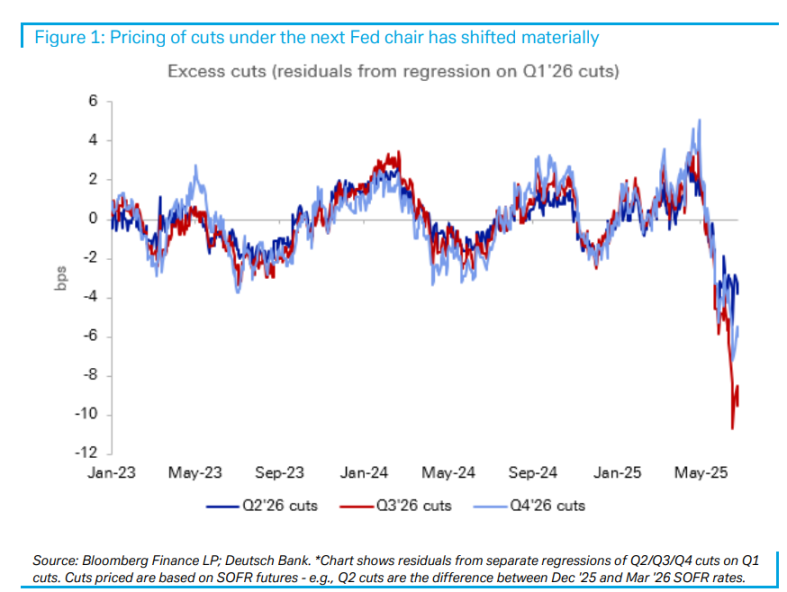Deutsche Bank stated that through statistical model analysis, it has discovered the phenomenon of "new chair premium," indicating that the market is pricing in the unusually accommodative policies during the new Federal Reserve chair's term, especially in the third quarter of 2026—right when the new chair takes office.
Written by: Dong Jing
Source: Wall Street View
Deutsche Bank's latest research report shows that market expectations for the Federal Reserve's policies next year have changed significantly, with the expectation that the new chair may push for continued accommodation.
On June 26, according to news from the trading desk, Deutsche Bank stated in its latest report that financial market expectations for the Federal Reserve's policies next year have changed significantly, particularly regarding the aggressive expectations for interest rate cuts after the new Federal Reserve chair takes office.
The current chair's term will expire in May next year; however, as noted in the Wall Street View article, Trump is considering announcing the next Federal Reserve chair as early as this summer, much earlier than the traditional 3-4 month transition period. Insiders revealed that Trump hopes to influence market expectations and monetary policy direction by announcing the successor in advance, allowing the "shadow chair" to start impacting before Powell's term ends.
The report also mentioned that since last week, following dovish remarks from Federal Reserve Governor Waller and other officials, the market has priced in an additional approximately 10 basis points for interest rate cuts before the end of the year.
Statistical models reveal unusual pricing for next year: the emergence of the "new chair premium"
Deutsche Bank noted that the most striking change has occurred in expectations for interest rate cuts in the middle of next year.
The report states that the market seems to increasingly expect that once the new Federal Reserve chair takes office, monetary policy will continue to be accommodative. The expiration of the current chair Powell's term in May next year has become a focal point for the market.
Deutsche Bank discovered an intriguing phenomenon through regression models: by regressing the pricing of interest rate cuts in the second, third, and fourth quarters of next year against the first quarter, they measured the "anomalous" degree of forward interest rate cut expectations relative to the first quarter through residual analysis.

Deutsche Bank found that over the past month, these residuals have significantly turned negative, particularly in the third quarter of 2026—right when the new chair takes office. This indicates that the market is pricing in an unusually accommodative policy during the new chair's term, a pricing pattern that deviates from historical norms in recent years.
Note: Residuals refer to the difference between actual observed values and estimated values (fitted values). "Residuals" contain important information about the fundamental assumptions of the model. If the regression model is correct, residuals can be viewed as observed errors.
However, the report also cautioned against being overly optimistic about this "new chair premium." This is because formulating monetary policy requires the support of a majority vote from the FOMC, and the new Federal Reserve chair will need to persuade colleagues to support a different policy trajectory. This institutional constraint implies that the discontinuity in policy pricing surrounding the new chair should be slight.
It is worth noting that even with the aforementioned discrepancies, the market's expectations for interest rate cuts in the second, third, and fourth quarters of 2026 are still lower than in the first quarter, indicating that the market does not expect a sharp policy shift but rather believes that the accommodative policies under the new chair will last longer.
Recent market pricing changes: Dovish remarks drive interest rate cut expectations
A previous article from Wall Street View pointed out that on Monday (June 23), Federal Reserve Governor Bowman stated that if inflationary pressures remain controlled, he would support an interest rate cut as early as July.
Bowman's reasoning is that risks in the labor market may be rising, while inflation seems to be stabilizing towards the Federal Reserve's 2% target. Last Friday, Federal Reserve Governor Waller, in an interview with CNBC, indicated that he might support an interest rate cut next month due to concerns about a weak labor market.
Deutsche Bank noted in its report that since last Thursday, the market has priced in an additional approximately 10 basis points for Federal Reserve interest rate cuts before the end of the year, primarily influenced by the dovish remarks from Governors Waller and Bowman. This change reflects investors' immediate response to a softening stance in Federal Reserve policy.
According to the latest data from FedWatch, the market is betting on a 20.7% probability of the Federal Reserve cutting rates in July, an increase from a week ago (12.5%), and traders have fully priced in expectations for a rate cut at the September meeting.
免责声明:本文章仅代表作者个人观点,不代表本平台的立场和观点。本文章仅供信息分享,不构成对任何人的任何投资建议。用户与作者之间的任何争议,与本平台无关。如网页中刊载的文章或图片涉及侵权,请提供相关的权利证明和身份证明发送邮件到support@aicoin.com,本平台相关工作人员将会进行核查。




